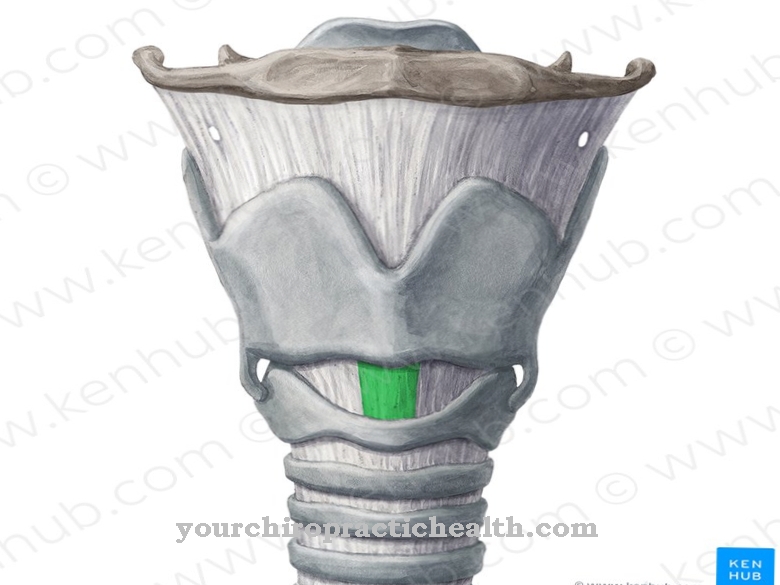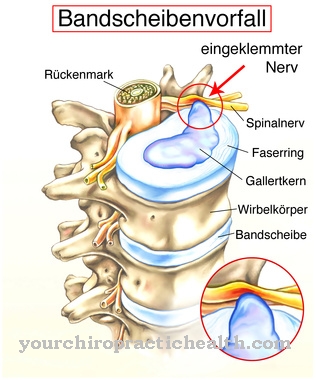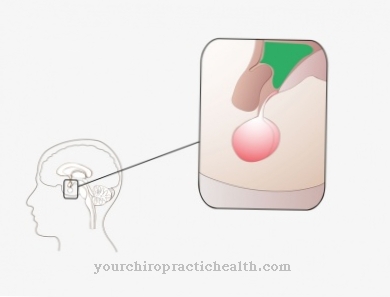The Ruffini corpuscles are class SA II mechanoreceptors found in the dermis, the skin of the tooth root and the joint capsules. The receptors register intero- and exteroceptive pressure or stretching and transmit these stimuli to the brain via the spinal cord. Mutations in the receptors are usually associated with abnormal sensations.
What is the Ruffini corpuscle?
The first instance of human perception are the so-called sensory cells.The most important sensory cells of the sense of touch are the mechanoreceptors, which detect stimuli such as pressure, touch and vibrations and translate them into the language of the central nervous system.
The skin senses have different mechanoreceptors, which either fall into the group of SA receptors, RA receptors or PC receptors. The Ruffini corpuscles are mechanoreceptors from the class of the SA-II receptors. These are slowly adapting sensory cells that have a certain resting potential frequency and respond in particular to stretching stimuli. The cells are named after the Italian anatomist Angelo Ruffini, who is considered to be the first to describe these receptors. As SA-II receptors, unlike SA-I receptors, Ruffini bodies are not inactive at rest and have a resting action potential frequency greater than zero.
Anatomy & structure
Ruffini bodies are located both in the skin and the periodontal membrane of the teeth and also in the joint capsules. In the skin, they are mainly found in the stratum reticulare within the dermis. All Ruffini corpuscles have an open cylinder-like shape and are flattened towards the ends. Collagen fiber bundles made of connective tissue enter the corpuscles through the cylindrical openings.
They exit the cells on the opposite side of their entry. Like other mechanoreceptors, the Ruffini bodies are equipped with free nerve endings and are thus freely exposed to the stimuli of the environment. The endings of the nerve fibers lie spirally between the fiber bundles made of collagen fibers. The afference is wrapped in insulating myelin, which improves the conductivity of the nerves and counteracts potential losses. The myelinated afferents of the Ruffini corpuscles are around 5 µm thick.
Function & tasks
Like all other mechanoreceptors, the Ruffini bodies are responsible for detecting pressure and touch and, after translation into the language of the central nervous system, transmit them to the brain. The Ruffini bodies in the dermis of the skin are so-called exteroceptors. They are responsible for the perception of external contact stimuli and react to both pressure and horizontal stretching. The Ruffini corpuscles in the joint capsules are to be distinguished from this.
They fall into the class of interoceptors and thus deal with the stimulus perception from within. The Ruffini corpuscles of the joint capsules play a role above all for depth sensitivity and their sense of position and are therefore among the proprioceptors. They register the position and deflection speed of joints in the joint capsule by reacting to pressure relationships. When stimuli act, Ruffini bodies generate a so-called action potential, which exceeds the potential of the cells when they are at rest. This action potential travels via the afferent nerves of the cells via the spinal cord into the central nervous system. The stimulus is only processed, sensory integrated, classified and interpreted in the brain.
Through the Ruffini corpuscles in the dermis, people feel touches of varying intensity. The Ruffini corpuscles in the joint capsules also give people a sense of self, which informs them of their own body position at all times. This relationship is required, for example, in order to carry out precisely controlled movements. Without position information from the joints, for example, the risk of dislocation and oversteering would be significantly higher. The proprioceptive Ruffini bodies work closely with the proprioceptive muscle spindles, which primarily collect information about muscle tension for the purpose of metering muscle strength.
You can find your medication here
➔ Medicines for paresthesia and circulatory disordersDiseases
In the past few years a new class of diseases has come to light: the receptor-associated disease. Such receptor-associated diseases go back to receptor mutations and contain a wide spectrum of individual hereditary and somatic diseases.
Mutations in the Ruffini corpuscles cause a defect: the affected receptors can no longer bind ligands, for example, no longer transmit signals or no longer translate the stimuli into the language of the central nervous system. In some cases, mutations in receptors such as the Ruffini bodies also cause inadequate production or inadequate integration of the receptors into the membrane. Sometimes the so-called ion channel diseases are also counted among the receptor-associated diseases. The same applies to autoimmune diseases, which form autoantibodies against the receptor structures and in this way cause inflammation in the receptors.
Poisoning can also damage receptors such as the Ruffini bodies. Ultimately, most complaints in the area of the mechanoreceptors are not due to the receptors themselves, but to the nerves connected to them or even in the brain, where the evaluation of the contact information takes place. Many neurological diseases can, for example, lead to incorrect or even lacking sensation of touch and position. One of the most common of these diseases is multiple sclerosis.
This disease causes autoimmune inflammation in the nervous tissue of the central nervous system and can thus affect both the brain and the supply lines of the spinal cord. Although the Ruffini bodies are intact, they can no longer transmit the registered information to the central nervous system after damage to their afferents. The consequence of this is partly not just discomfort from external pressure. The inability to dose joint deflections can also be a result of damaged afferents in the Ruffini corpuscles.




.jpg)







.jpg)



.jpg)










.jpg)
